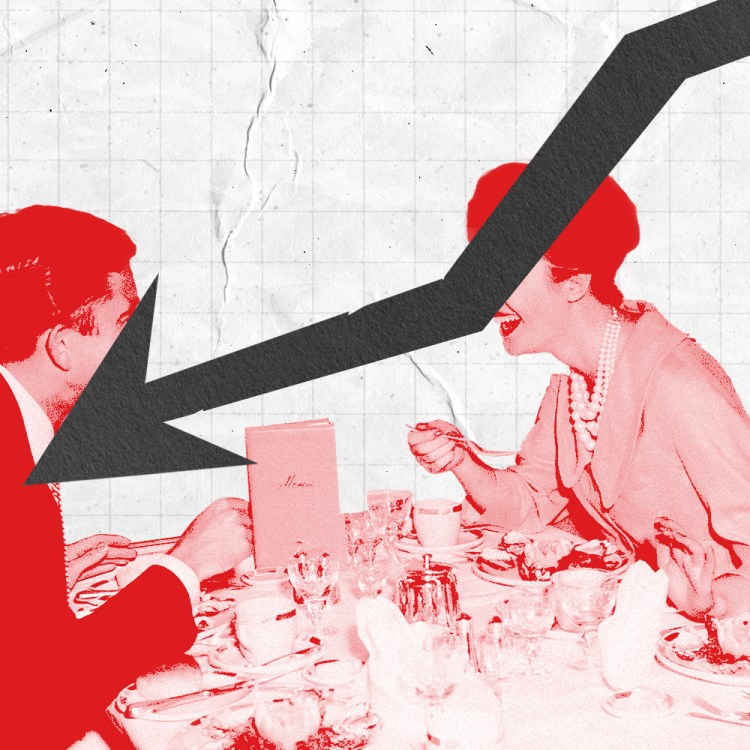If you were to stage a Billy on the Street survey, only you were screaming at people to name an ultra-processed food instead of a woman, you’d probably get the same answers over and over again: Doritos, Oreos, Coke.
The phrase “ultra-processed” made its way into academic discourse over 15 years ago, but it’s taken a while for Americans to grasp that the term encompasses far more than the junkiest grocery aisle. In fact, it’s now estimated that up to 58% of the average American diet is comprised of ultra-processed foods, or UPFs — the shorthand for foods that are industrially processed, contain added ingredients like preservatives, emulsifiers or colorings, and bear only blurry resemblance to their whole-food origins.
Name an ultra-processed food? You actually have tons of options: Nature Valley granola bars, Chobani yogurts, Vitaminwater sports drinks, Bertolli pasta sauces, Sabra hummus. Even packaged whole wheat bread — like cult-favorite Dave’s Killer Bread — qualifies, as does a range of other products marketed under the “health halo” glow. Think plant-based meats and alternative milks.
Many UPFs are engineered to override natural satiety signals. Most are designed to outlast the apocalypse. And practically all of them are cheap, accessible…and impossible to whip up in a home kitchen. They’re modern “foodlike substances,” to quote the great nutrition journalist Michael Pollan, and they’re feeding into distinctly modern problems. There is a direct link between the rise of UPFs and the rise of obesity, metabolic disease and diet-related illness — fueled in part by their impact on the gut microbiome, where they disrupt beneficial bacteria and promote inflammation in ways we’re only beginning to understand.
At this point, the question isn’t whether UPFs are bad for us. The evidence is overwhelming. The real question is what to do about it — because UPFs aren’t going anywhere. Cutting them out entirely is unrealistic, but understanding how they shape our diets, and knowing where to make smarter swaps, can go a long way. So here’s your survivor’s guide to UPFs. Take that title literally, because it’s about time we started taking ultra-processed food seriously.
100 Ways to Live to 100: The Longevity Fitness Guide
Coastal living, board games, not eating hot dogs. It’s all in here.Why Is “Ultra-Processed” a Thing Right Now?
Brazilian Origins
The term “ultra-processed foods” has actually been around since 2009, when Brazilian epidemiologist Carlos Monteiro introduced Nova, a classification system that redefined how we think about processed food.
A professor at the University of São Paulo, Monteiro was puzzled: Brazilians were consuming less raw sugar than in years before, yet obesity rates were climbing. The answer wasn’t in sugar itself, but in where it was coming from — hidden inside ready-to-eat packaged foods. He reached an unexpected conclusion: households with bags of sugar in the pantry were likely healthier, as they were still cooking from scratch.
By 2014, Brazil took the then-radical step of officially advising its citizens to avoid UPFs, structuring its national dietary guidelines around Monteiro’s research and the Nova system. But in the U.S., it’s taken another decade for both the research and the conversation around it to fully break into the mainstream.
A Massive Study inThe BMJ
A 2024 mega-study in The BMJ helped accelerate that shift. Titled “Ultra-processed food exposure and adverse health outcomes,” the meta-analysis examined 45 studies covering nearly 10 million people — and found direct links between UPF consumption and 32 different health conditions.
The study described a shift towards an increasingly ultra-processed global diet and defined UPFs as “industrial formulations primarily composed of chemically modified substances extracted from foods, along with additives to enhance taste, texture, appearance, and durability, with minimal to no inclusion of whole foods.”
It was the first umbrella review of its kind, and its findings were alarming: greater exposure to ultra-processed foods was directly associated with higher risks of all-cause mortality, cardiovascular disease, mental health disorders, obesity and type 2 diabetes. Also flagged for further study? Possible links to asthma, gastrointestinal issues, some cancers and key metabolic risk factors.
The Great Satiety Debate
Before The BMJ meta-analysis, there was also a 2019 study published in Cell Metabolism by NIH Clinical Center researchers. It found that people unknowingly ate 500 more calories a day on a UPF diet compared to a whole-food diet and helped establish the concept that UPFs don’t just contribute to poor nutrition — they actively drive overeating by bypassing natural satiety signals. In other words, UPFs make it dangerously easy to consume excess calories without realizing it.
In the age of weight-loss drugs like Ozempic and Wegovy, this sort of knowledge is a huge deal. Nearly 13% of American adults have taken GLP-1 medications that suppress cravings and reduce food intake. But all this attention on satiety raises an uncomfortable question: is overconsumption a personal failing, or a food problem? And if it’s the latter — which the research increasingly suggests — why is the solution pharmaceutical? Why not start with the food itself?
Elsewhere in the News
- Last year, a landmark lawsuit was filed against major food companies, alleging that Coca-Cola, Kraft Heinz, General Mills, PepsiCo and others followed a “1980s cigarette playbook” to hook consumers, fueling a public health crisis of childhood obesity, diabetes and fatty liver disease.
- Red Dye No. 3, a synthetic food coloring found in candies, baked goods and fruit drinks, was recently banned by the U.S. Food and Drug Administration.
- Anti-establishment influencers, biohackers and the likes of Robert F. Kennedy Jr. have broadcast their own scattershot messaging on the issue — often framing the fight against UPFs as a matter of personal liberty while offering little in the way of actual policy solutions.
- France proposed a tax on high-sugar processed foods, while the U.K. is considering new labeling laws and junk food taxes, signaling a growing push for regulation in Europe.
- In 2023, a British doctor named Chris van Tulleken released the book Ultra-Processed People, which chronicles how he put himself on an all-ultra-processed diet for four weeks and saw shocking health declines, including weight gain, anxiety and digestive issues.
- Big Food is quietly reformulating products, funding studies that downplay health risks and lobbying against regulation, mirroring the sugar industry’s past resistance to soda taxes.
- Scientists are increasingly linking UPFs to disruptions in the gut microbiome, with evidence that emulsifiers, artificial sweeteners and refined carbohydrates alter beneficial bacteria. This contributes to inflammation, metabolic disease and mental health issues.
How to Lower Your Resting Heart Rate Below 60 BPM
Make like an elite athlete and slow down your tickerThe Worst Offenders
According to Marion Nestle, a professor emerita of nutrition, food studies and public health at New York University, and a titan in American nutritional science discourse, the idea that UPFs “can’t be made in home kitchens” is crucial to our collective understanding of the issue.
“[Ultra-processed] defines a category of junk food that is industrially produced…and formulated to be irresistible if not addictive,” Nestle told InsideHook. “[This sort of food] is now everywhere, in huge portions, and socially acceptable to eat any time, anywhere, in impossibly large amounts.”
It’s going to take a lot for the multi-trillion-dollar food and beverage industry to scale back its production of UPFs. Nestle says we’ll need targeted taxes, restrictions on marketing and warning labels to start. But it’ll be a steep uphill battle, to say the least. According to Michael Moss, the Pulitzer Prize-winning reporter and author of Salt Sugar Fat and Hooked, “[The food industry] is addicted to revenue, and so time and again efforts at reform from within the industry have failed when investors press back for more profits.”
Remember those reports that Silicon Valley executives didn’t want their own families using the tech they sold to the masses? There’s a similar situation going on here. As Moss told InsideHook: “Their own people don’t eat their products. At least not those at the top and in management. They know better and can afford to eat better.”
Well, if they know better, we should too. Your best chance at surviving — with the potential for even thriving — within a system you neither created nor asked for is to understand A) how to identify UPFs, and B) how avoid them when possible.
Is that a perfect dietary north star? Not necessarily. Plenty of minimally-processed foods aren’t necessarily nutritious. (A cookie baked from raw, whole-food ingredients is still a cookie.) And you also don’t want to reorient your life around evading UPFs at all costs. You’d be a real drip at birthday parties. Still, in the words of Nestle: “[Avoiding UPFs] can’t hurt. And it could help a lot.”
How to Spot UPFs in the Grocery Store
- More than five ingredients? Proceed with caution.
The longer the ingredient list, the more likely you’re dealing with a heavily processed product. Look out for emulsifiers, stabilizers, and preservatives — these help food stay “fresh” for months or even years.
- If you don’t cook with it, why would you eat it?
If a product’s ingredient list includes things you’d never use in a home kitchen, it’s probably ultra-processed. Red-flag ingredients to look out for: carrageenan, maltodextrin, soy lecithin, soy protein isolate, modified food starch, wheat gluten, glycerin, xanthan gum, guar gum, cellulose gum, monoglycerides, sodium caseinate and high-fructose corn syrup. We recommend trying your hand at this supermarket game from The New York Times to get better at identifying UPFs.
- Beware health halos
Labels like “plant-based,” “high protein” or “whole grain” don’t necessarily mean a food is minimally processed. Many UPFs marketed as healthy alternatives are still just as engineered as traditional junk food.
Some core examples: breakfast cereals, frozen meals, snack bags, energy bars, sports drinks, sodas, packaged meats, plant-based meats, jarred sauces and condiments, flavored yogurts, instant noodles, protein shakes, coffee creamers, packaged baked goods, pre-mixed salad dressings
How to Spot UPFs Out and About
- If it’s uniform across locations, it’s probably engineered
Chains rely on pre-made sauces, dressings and bases that make sure taste never changes. That’s super convenient when you’re on a business trip — you know exactly what to expect. But know that even in “fresh” fast-casual spots like Panera, you’re probably eating heavily processed ingredients.
- Beware of “liquid calories”
Countless bottled drinks, smoothies and coffee shop beverages are loaded with stabilizers, emulsifiers and artificial sweeteners designed to extend shelf life and enhance texture. Stick with water when you can, or bring along a thermos with your homemade coffee or smoothie of choice.
- Packaged = processed
Even if a grab-and-go item looks fresh, check the packaging. Pre-made salads, protein snack packs and bottled dressings are usually full of preservatives and industrial oils.
Some core examples: fast-casual chains, coffee shop staples, convenience stores at gas stations and airports, salad bars and buffets
12 “Slow Living” Strategies That Will Increase Your Longevity
You don’t have to live off the grid to put these habits to good useWhat UPFs Do to the Body
The pitch for UPFs, insofar as there even is one: they’re cheap. You don’t have to look hard to find them, and you don’t have to pay much. But whatever time and money you save up front will almost certainly rob years from your life — while potentially costing you tens of thousands in medical bills. One in six American adults now have diabetes, up from one in 10 in 2000. It’s costing the country $413 billion annually.
Simply put, UPFs are inextricably linked with all-cause mortality. As grim as that sounds, it might also feel…theoretical. Like UPFs are some far-off health concern that won’t catch up with you for decades. If you’ve already brushed off the (admittedly exhausting) longevity movement, maybe this feels like another topic to tune out. Why stress over UPFs? A bag of Doritos here and there — much less a Chobani — doesn’t seem worth the mental migraine.
But look: Unhealthy eating can also cause migraines.
The impact of UPFs isn’t abstract or distant — the damage starts immediately. Energy levels, digestion and hunger cues are all thrown out of whack from the first bite. And over time, those effects don’t just linger. They compound. Chronic disease follows…and life expectancy shrinks.
Short-Term Effects
- Blood sugar spikes
UPFs digest rapidly, flooding your system with sugar and triggering insulin spikes. So, Michael Scott-style, you’ll often get a quick burst of energy followed by a hard crash, leading to fatigue, irritability and (eventually) more cravings.
- Increased hunger and overeating
Again, UPFs are designed for taste, not satiety. They override natural hunger cues, making mindless overeating the default, not the exception. Ever hear someone say, “Oh, I can eat the whole bag,” like it’s a personal quirk? It’s not. That’s how these foods are built.
- Gut disruption and bloating
Your gut bacteria didn’t sign up for this. All those emulsifiers, artificial sweeteners and preservatives found in UPFs disrupt your delicate microbiome, leading to a day of bloating, gas and general digestive discomfort.
- Brain fog and fatigue
It’s 2 p.m. You’re sitting at your desk, bloated from a deli turkey sandwich, a bag of chips, and a soda…and now you can’t focus. One UPF-laden lunch is all it takes to bring on the dreaded afternoon slump — sluggish, foggy, counting the minutes till caffeine or quitting time.
Long-Term Effects
- Weight gain
Eat UPFs regularly, and your body spends a lifetime in defense mode. It stores more fat, spikes insulin and edges toward metabolic dysfunction. Think: a higher risk of obesity and the slow creep of health problems outlined in that important BMJ study.
- Chronic inflammation
Processed seed oils, refined sugars and all those other difficult-to-pronounce additives fuel chronic inflammation, which is the invisible fire behind heart disease, type 2 diabetes and a range of debilitating autoimmune conditions.
- Gut disruption
We’re back to the microbiome. UPFs wreak havoc on gut health, paving the way for IBS and increased intestinal permeability (also known as “leaky gut“).
- Mental health disorders
The gut-brain connection is real! Research consistently links ultra-processed diets to higher rates of depression and anxiety. In one study, greater consumption of UPFs was associated with a 22% increase in the risk of depression over time.
What Can You Do? (Beyond Avoiding UPFs.)
Hammer the Good Stuff
We appreciated this advice from Moss: “Processed food is even more addictive [than cigarettes and alcohol]…trying to eat just a handful of potato chips isn’t feasible. Really smart nutritionists have suggested to me another approach — instead of thinking about reducing your processed food, focus first on finding ways to add vegetables and fruits and whole grains to your eating.”
Rather than obsessing over every ingredient label, crowd out the bad by prioritizing the good: fiber, protein and nutrient-dense whole foods. The more you build meals around whole grains, leafy greens and lean proteins, the less room there is (literally) for ultra-processed fillers.
Don’t Stress Light Processing
If you get into the weeds on all this, you’ll quickly learn that the majority of foods undergo some sort of processing — but that’s not inherently bad. This is where Monteiro’s Nova system comes back into play.
For instance: canned beans are blanched and preserved in water and salt. Fresh sourdough bread is baked with milled flour. Yogurts (without additives) are made from pasteurized milk and fermented bacteria. They each fall under the category of Nova 3: Processed Food. And they’re all perfectly fine. Look, we’re not trying to live in the 1700s. The real problem isn’t processing itself — it’s when foods are industrially restructured to be hyper-palatable, shelf-stable and biologically disruptive.
Move Your Body
There’s no instant undo button for a body built on UPFs. But regular movement can help counteract the damage. Exercise improves insulin sensitivity, reduces inflammation and supports gut health. So start lifting weights, going to yoga classes, penciling in digestive walks. Anything. The more you move, the better chance your body has at regulating blood sugar, fighting inflammation and repairing itself. And the more you lean into your exercise routine, the less inclined you’ll be to fuel with foods that only slow you down.
The Charge will help you move better, think clearer and stay in the game longer. Subscribe to our wellness newsletter today.

























